
- Home
- Brand
- American Vintage (25)
- Carolyn Pollack (7)
- Estate (17)
- Fred Harvey (24)
- Fred Harvey Era (38)
- Hand Made (7)
- Handmade (222)
- Larry Moses Begay (10)
- Native American (852)
- Native Treasure (11)
- Nativo Arts (75)
- Navajo (26)
- Old Pawn (97)
- Perry Null Trading (14)
- Southwestartisans (29)
- Southwestern (17)
- Sterling (81)
- Topgems (10)
- Unknown (10)
- Zuni (39)
- ... (4554)
- Metal
- Metal Purity
- , 925 Silver (45)
- .900 Or Higher (21)
- .925 (673)
- .925 Silver (7)
- .925 Sterling (23)
- .925 Sterling Silver (22)
- .925, Sterling (151)
- 0.925 (6)
- 14k (17)
- 9.25 Silver (39)
- 92.5 (5)
- 900 (10)
- 925 / 1000 (13)
- 925 Parts Per 1000 (16)
- Silver (6)
- Sterling (83)
- Sterling Silver (113)
- Unknown (35)
- 925 (1335)
- 925 Sterling Silver (7)
- ... (3538)
- Shape
- Theme
- Type
- Bracelet (6)
- Brooch (874)
- Brooch & Pin (7)
- Brooch / Pendant (8)
- Brooch / Pin (21)
- Brooch Pendant (12)
- Brooch Pin (44)
- Brooch Pin / Pendant (4)
- Brooches / Pins (5)
- Necklace (23)
- Necklace / Pendant (5)
- Pendant (121)
- Pendant / Brooch (5)
- Pendant / Necklace (5)
- Pendant / Pin (19)
- Pin (706)
- Pin / Brooch (50)
- Pin / Pendant (53)
- Pin Pendant (18)
- Pin, Pendant (11)
- ... (4168)
Historic Dan Simplicio Zuni Pin/Pendant ca 1940's, Bisbee Turquoise Red Coral
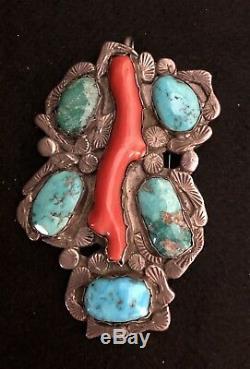
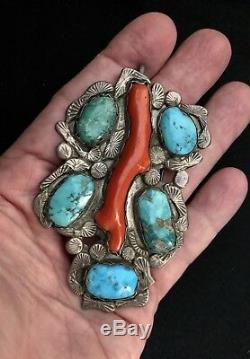
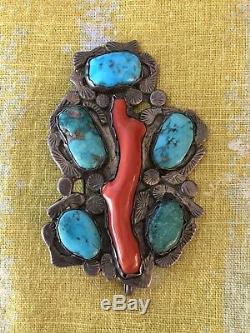
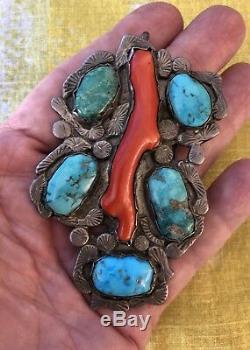
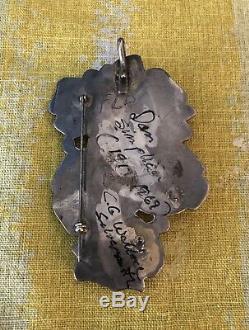
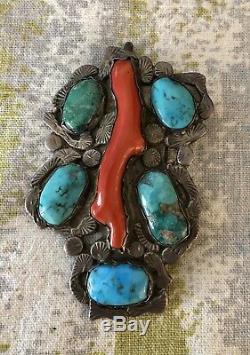
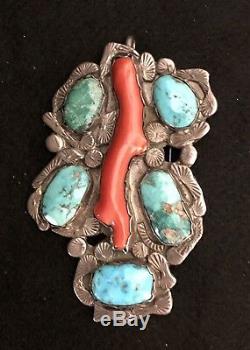
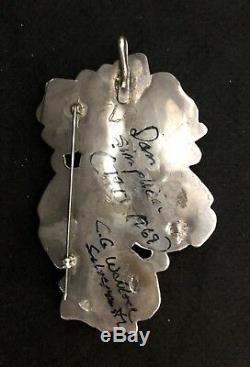
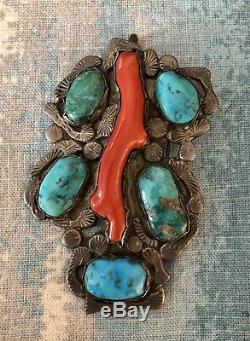
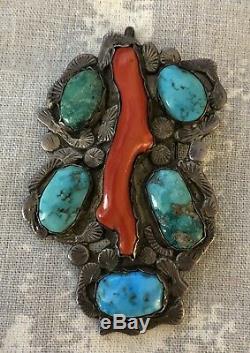
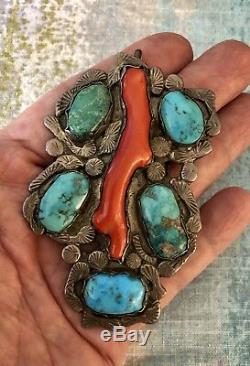


This lovely pin/pendant combination by Dan Simplicio, is masterfully crafted with his use of beautiful materials. This pin offers the best of Simplicio's work, with his large stamped sun ray drops and branches. Also beautiful Bisbee turquoise stones and deep red coral branch are the final touches added to this pretty pin/pendant combination. The pin/pendant measures from 3 3/4" by 2 1/4". Wear it as a statement pin, or wear it as a necklace. Here is Dan Simplicio's Bio from "Art of the Zuni". Dan Simplicio (1917 - 1969). Dan Simplicio learned jewelry making from his uncle, Juan Dedios. He, in turn, passed his knowledge on to younger Zuni artists, including his son Mike Simplicio and his nephew Juan Calavaza. One of the most innovative and wide-ranging Zuni artists, Simplicio was the first to develop styles and materials usage that have since become commonplace. He collaborated with a number of the most widely recognized masters of Zuni art, including Leekya Deyuse, Teddie Weahkee, Leo Poblano, Bernard Homer, and Lee Edaakie. Early in his career, Simplicio worked at C. Wallace's Zuni trading post, grinding and setting stones.
Wallace collected his work; and, when his collection was auctioned at Sotheby's in 1975, it included more than 50 pieces by Simplicio. Simplicio was the first to use branch coral in its natural form and the first to set rough-cut coral nuggets on rings. He originated the nugget style around 1948, in an attempt to make cheaper commercial imitation of Zuni jewelry more difficult, and he introduced extensive use of leafwork in Zuni jewelry. While Simplicio learned to carve leaves from Juan Dedios, his son, Dan Simplicio, Jr. Credits his father's World War II army service in Europe with the development of this innovation.
Stationed in France, Germany and Italy, he observed the use of leafwork in classical and modern Western European sculpture. The present generation of Simplicio family jewelers have carried on the use of the distinctively curved leaves that Dan originated. However, their leaves curve in the opposite direction from his, making it easy to distinguish their work. Simplicio's jewelry has a highly individual look, resulting from its distinctive use of deep red branch coral with intense blue turquoise.
Silver leafwork and stamped drops add texture and detail, creating a delicate counterpoint to the heavier turquoise and branch coral. This is an excellent piece that can be enjoyed as a collection and simply to wear.
The item "Historic Dan Simplicio Zuni Pin/Pendant ca 1940's, Bisbee Turquoise Red Coral" is in sale since Thursday, January 24, 2019. This item is in the category "Jewelry & Watches\Ethnic, Regional & Tribal\Native American\Necklaces & Pendants". The seller is "icollect_65" and is located in Seminole, Florida. This item can be shipped worldwide.- Jewelry Type: Pendants
- Main Stone: Turquoise
- Tribal Affiliation: Zuni
- Metal: Sterling Silver
- Country of Origin: United States

